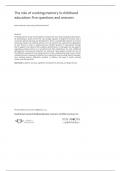The role of working memory in childhood education: Five questions and answers
Kate Cockcroft, University of Witwatersrand.*
Abstract
Working memory is the mental ability to temporarily store and manipulate information. Its functioning is distinct from the vast storage capacity of long-term memory and is crucial for optimal learning and development. There is considerable research on several theoretical aspects of working memory. Far less research has explored the application of such theory in order to understand how children perform in educational settings and to support and improve their academic performance. In this paper, five key aspects regarding working memory are considered and their implications for early childhood development, learning and education are discussed. These aspects include the role of the different components of working memory in early childhood learning, ways in which working memory is assessed in children, how verbal and visual working memory develop, how working memory difficulties manifest in children, and ways in which working memory can be improved.
Keywords: academic success, cognition, development, learning, working memory
*Email address: kate.cockcroft@wits.ac.za.
South African Journal of Childhood Education | 2015 5(1): 1-18 | ISSN: 2223-7674 |© UJ SAJCE – June 2015
2Introduction: Taking a construct from the psychology laboratory and theory to the practice of childhood education The process that enables humans to mentally hold small amounts of information in a readily accessible state and to use them in complex cognitive tasks is known as working memory. It interacts closely with long-term memory and enables us to plan, reason, solve problems, read, write and abstract the gist of information (Baddeley & Hitch 1974; St Clair-Thompson, Stevens, Hunt & Bolder 2010). It is therefore unsurprising that working memory is one of the most widely researched constructs in education and psychology (Cowan 2014). However, while much research has focused on the theoretical aspects of working memory, far less work has been concerned with how an understanding of working memory can be applied to everyday situations. Translation of laboratory findings to everyday application is often a major challenge, and one needs to be cautious when extrapolating from such tightly controlled research environments to uncontrollable everyday situations. Furthermore, most working memory research has focused predominantly on adult populations, with considerably less attention paid to working memory in children. Understanding how working memory operates and can be enhanced has relevance for all aspects of our lives, and particularly for how children learn, since it is heavily implicated in classroom activities that involve following instructions, focusing and completing tasks (Gathercole & Alloway 2008; Holmes & Gathercole 2014). In this article, I pose and answer five questions related to working memory and its application to childhood education, learning and development. In answering these questions, I critically consider the effective translation of current research findings to the school and home learning environments. Why is working memory so important for childhood learning and education?
There is considerable evidence linking performance on working memory tasks to vocabulary acquisition (Engel de Abreu, Gathercole 2006; Gathercole & Martin 2011); early academic success in reading (Gathercole & Alloway 2008; Stevenson, Bergwerff, Heisera & Resinga 2014); mathematics (Arndt, Sahr, Opfermann et al 2013; Bull & Scerif 2001; DeStefano & LeFevre 2004); and comprehension (Cain, Oakhill & Bryant 2004; Seigneuric, Ehrlich, Oakhill & Yuill 2000). Furthermore, measurements of working memory ability taken at the commencement of formal education are much stronger predictors of success in reading, spelling and mathematics than IQ scores (Alloway 2008; Alloway & Alloway 2010) and short-term memory ability (Engle, Tuholski, Laughlin & Conway 1999). In order to understand the relationship between working memory and academic performance, it is necessary to first provide some theoretical detail.
Baddeley’s (2000; 2003) working memory model is the best known, most researched and most widely accepted theoretical model, although many other equally feasible models exist (for example, Anderson 1983; Cowan 2008; Ericsson & Kintsch 1995; Miyake & Shah 1999; Oberauer 2005). These models differ primarily in their conceptualization of the relationship between working memory and long-term Kate Cockcroft – The role of working memory in childhood education
3memory, the nature of the executive control mechanism(s), and the capacity of working memory. They are, however, in general agreement that working memory comprises several components or processes that operate in a coordinated manner in order to temporarily store and manipulate information (Baddeley 2003; Cowan 2008; Ericsson & Kintsch 1995; Miyake & Shah 1999; Oberauer 2005). These components include separate verbal and visuospatial subsystems – the phonological loop and the visuospatial sketchpad, respectively – each of which has a limited capacity. The phonological loop consists of a phonological store (for passive storage) and an articulatory rehearsal system (for active rehearsal and maintenance of information). These processes are responsible for integrating auditory information into meaningful sounds, such as phonemes, words and sentences. The visuospatial sketchpad is similarly subdivided into the visual cache (for storage of static visual/spatial information) and the inner scribe (for rehearsal) (Buchsbaum 2013; Logie 1995). These processes are critical for interpreting and integrating information from the visual world around us, which would otherwise constitute a series of disjointed snapshots (Simmering 2012). Evidence suggests that visual and spatial information are separate in working memory, and this is supported by different anatomical brain locations for the storage and processing of visual as opposed to spatial information (Holmes, Adams & Hamilton 2008). Central Executive
Visuo-spatial sketchpad
Visual SemanticsLong term memoryLanguageEpisodic BufferPhonological loop
Figure 1. Schematic representation of working memory.
In addition to the modality specificity of these components (verbal, visual and spatial), a key aspect of this model is the distinction between simple, short-term memory (brief storage only, with no explicit processing) and complex manipulation or processing of information (See Cowan 2008 for a detailed discussion). Neuroimaging studies confirm these distinctions, with simple, storage-only tasks activating brain areas related to the to-be remembered information (for example, Broca’s area in the




